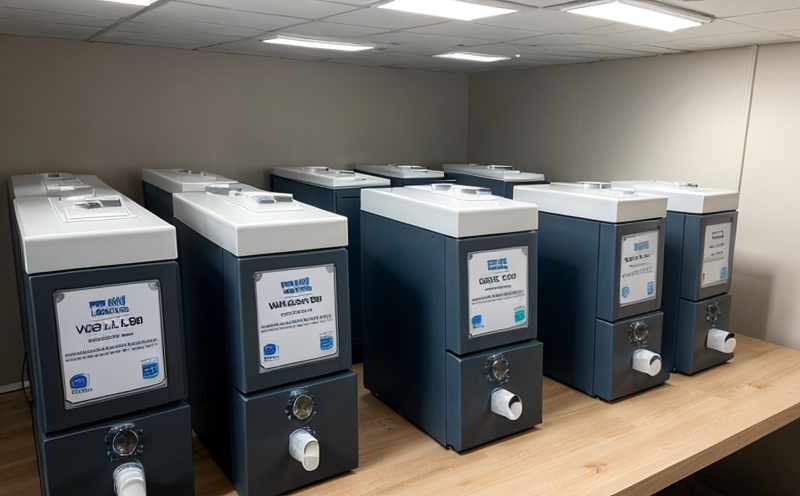ISO 16000-9 Determination of VOC emissions Chamber method
The ISO 16000 series is a collection of international standards that provide guidelines for the measurement, testing, and evaluation of indoor air quality. One specific standard within this series, ISO 16000-9, focuses on determining volatile organic compounds (VOCs) emissions from materials using the chamber method.
This method is particularly important in sectors such as textiles, furniture manufacturing, and construction where emissions of harmful chemicals can affect indoor air quality. The chamber method involves enclosing a specimen within a sealed chamber to measure the outgassing or emission rates of VOCs over time. It provides valuable data for compliance with various national and international regulations.
The process typically begins with carefully selecting and preparing the test specimens according to ISO standards. This may include cutting samples from fabric, foam, or other materials that are suspected sources of VOC emissions. Once prepared, these specimens are placed into a climate-controlled chamber where conditions can be precisely controlled for temperature, humidity, and air flow.
The chamber then introduces a known volume of air over the specimen and maintains this environment for an extended period. During this time, any volatile compounds released by the material are captured and analyzed using gas chromatography techniques or other analytical methods specified in ISO 16000-9. The amount of VOCs detected is measured against established thresholds to determine compliance with relevant standards.
The significance of this testing cannot be overstated, especially given growing concerns about indoor air quality and health impacts associated with exposure to certain VOCs. By employing the ISO 16000-9 protocol, laboratories ensure accurate and reproducible results that can inform product development decisions aimed at reducing harmful emissions.
- Environmental Impact: Reducing VOC emissions helps mitigate indoor air pollution, which is beneficial for both human health and the environment.
- Sustainability Benefits: Lowering the use of materials that release high levels of VOCs supports sustainable practices in manufacturing processes.
Applied Standards
The ISO 16000-9 standard is widely recognized and applied across various industries, including textiles, furniture production, and building materials. It aligns closely with other relevant international standards such as ASTM E1548 and EN 13986.
For the textile sector, this method ensures that products meet stringent environmental requirements set by organizations like Oeko-Tex Standard 100 or REACH regulations. Compliance with these standards not only enhances product safety but also builds consumer trust through transparent labeling and marketing claims about eco-friendly materials.
The chamber method described in ISO 16000-9 is particularly useful for identifying potential sources of indoor air pollution before they reach the market. This proactive approach allows manufacturers to identify issues early in the design process, enabling them to make informed changes that reduce harmful emissions without compromising performance or aesthetic qualities.
When integrated into a broader quality assurance framework, this testing ensures consistent product quality while contributing positively towards environmental sustainability goals. By adhering to these international standards, companies can demonstrate their commitment to responsible manufacturing practices and contribute to healthier living environments for consumers worldwide.
Environmental and Sustainability Contributions
- Avoidance of Harmful Emissions: By identifying VOC emissions early, manufacturers can take corrective actions that prevent these compounds from entering the atmosphere or affecting indoor spaces.
- Improved Product Quality: The use of this method helps in developing safer and more durable products by ensuring they meet strict emission limits specified by regulatory bodies.
The ISO 16000-9 standard plays a crucial role in promoting sustainable practices within the textile industry. It encourages companies to adopt greener manufacturing processes, which ultimately leads to reduced energy consumption and waste generation throughout the production lifecycle of textiles. Additionally, it fosters innovation by driving research into alternative materials that are less prone to releasing harmful VOCs.
Moreover, compliance with this standard can lead to certification under programs like Oeko-Tex Standard 100, which enhances brand reputation and market competitiveness. Consumers increasingly seek out eco-friendly products, making adherence to such standards an essential part of staying relevant in today’s marketplace.
Use Cases and Application Examples
- Fabric Manufacturing: Textile manufacturers can use the ISO 16000-9 method to test raw materials like cotton, polyester blends, or synthetic fibers before incorporating them into finished products.
- Furniture Production: Upholstery fabrics and foam padding used in furniture can be tested for VOC emissions using this chamber method to ensure they comply with relevant regulations.
- BUILDINGS: Construction materials such as insulation foams, paints, and adhesives can undergo this testing prior to installation in residential or commercial buildings.
In each of these scenarios, the chamber method allows for precise measurement of VOC emissions under controlled conditions. This information is invaluable for manufacturers who need to demonstrate compliance with local or international standards related to indoor air quality and chemical safety.





